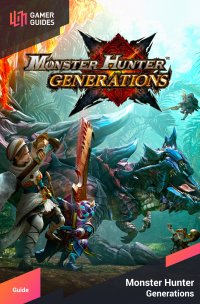Monsters in this game do have specific numbers of hit points. You just don’t see it. Before we dive into what the hit points can signify to you, let’s discuss some misconceptions and myths about them.
First, there are no health bars. You can’t see the monster’s hit points or how much health is left. You will have to watch for signs that they are exhausted, such as standing around and drooling, or finding a place to eat something. Once they’ve reached a critically low threshold, they will limp and try to catch some sleep.
Finally, hit points are not going to be your only indication of how beefy a monster is. The monster also has its own defense stats which are, again, kept hidden to the player. Defense varies by part and by what type of weapon is hitting it. For example, cutting weapons won’t do as much damage to a monster’s head as an impact weapon because the head has more resilience to cutting type weapons than to impact, which can effectively bash its face in. As a result, each monster in the game have their bodies broken into different zones with different defenses. Zones of the body that can break or be severed , will have thresholds appended to them as well that will indicate when the part is intact and when it gets broken or severed.
Additionally, different quests have different overall defense values attached to the monster. So why are those High Rank monsters a little more difficult to kill? They have higher overall defense. The overall defense is a percentage. This represents the percentage of your attack damage that will actually hit the monster. That percent will go down as you work your way up the ladder. Tricky!
So what does that have to do with motion values ? Well, motion values are what determine the power of your weapon, and thus, the damage you’re doing to a monster to reduce its hit points to zero (which is when the monster dies). Each weapon has its maximum attack damage potential, which is your weapon’s actual attack power. This means if you have a Great Sword with 150 power, that’s the max amount of numerical damage it can inflict on the monster. No guesswork there!
However, you’re not going to be inflicting 150 power each and every time you attack. Rather, each attack has a motion value that is a percentage of your maximum damage (150). Longer, slower motions will have higher percentages (e.g. Great Sword level 3 charge), and faster, shorter motions have much lower percentages (e.g. Dual Blades for…well…anything). This is but one factor that affects how much damage you do.
Obviously, motion values are an aspect of this game that keeps all fourteen weapons + Prowler Mode well-balanced, preventing one weapon from usurping all others. Note that motion values differ slightly between hunting styles as well. Notably, the Aerial Style Great Sword’s charge attack has a lower motion value than the other styles, which lets you do a traditional charge attack on the ground. That’s because it’s faster and so it’s easier to pull off. Makes sense, right?
Here is an example. The Great Sword’s traditional level 3 charge has a full 100% motion value. This means that the Great Sword deals damage to its fullest potential! Super awesome, right?! In comparison, the Sword and Shield’s most powerful attack, the charged slash, is a double hit attack. The first hit deals 20% of full damage, the second hit deals 34% of full damage. Much, much lower, despite being the Sword and Shield’s strongest damage option. This is because the Sword and Shield can attack much faster than the Great Sword!
For those wondering what the Aerial Style Great Sword’s level 3 charge does, it’s 75% of full damage compared to the other three styles’ 100%.

 Sign up
Sign up

No Comments